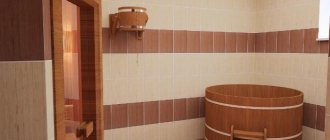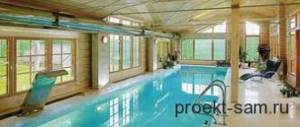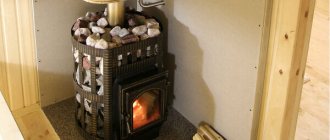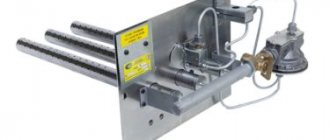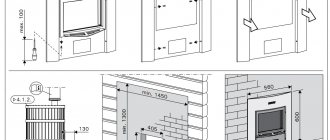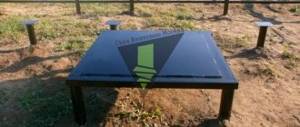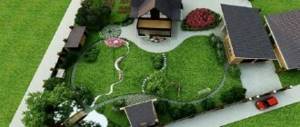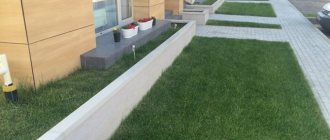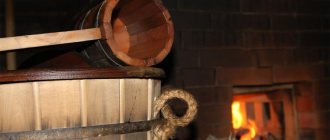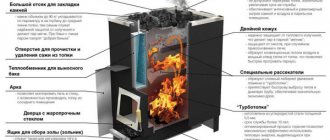Home / Installation, repair, maintenance / Decorating the walls near the stove - what heat-resistant panels are used?
To prevent such a nuisance as a fire from happening, heat-resistant materials are used to decorate the walls near the stove. Any such heat source not only heats the air in the room, but also heats up itself very strongly and therefore, the surrounding partitions can easily catch fire. In our case, these are walls and floors.
Fire-resistant sheet materials for stove and fireplace protective screens
Protective screens made of steel sheets are mostly used for metal combustion products to insulate their side walls. They are installed at a distance of up to 5 cm from the walls of the heating device and reduce thermal radiation.
Screens can be side or front. With their help, the temperature on the outer surfaces of combustion systems is reduced to +100 °C, which improves fire safety. Installation of convenient protective screens is simple and is carried out by attaching them to the floor using special legs.
Side protective screen
Other options
You can take a different route and build a protective screen around a heat source made of stone or brick. However, such structures are quite cumbersome and require some mason skills for construction and quite a lot of time for installation. Therefore, much more often, any sheet non-combustible material from those discussed above is used to decorate the walls behind the stove.
A sufficient degree of insulation and a very beautiful appearance can be ensured by decorating the surface with terracotta or ceramic tiles. However, in this case, the firebox will have to be placed at a distance of at least 30 centimeters from the walls. This is not particularly much, but in some situations it can become a problem. If aesthetics are still important, in such a situation you can create mixed protection: assemble the surface from non-combustible plasterboard or mineralite and finish it with terracotta tiles.
Reflective trim
It is effective to use cladding consisting of fire-resistant sheets in combination with non-flammable thermal insulation composites.
Fire-resistant sheet materials are mounted on top of thermal insulation; it is preferable to use stainless steel sheets for such cladding, since galvanized steel sheets can release toxic substances into the air when heated. To make the protection more effective, the steel sheet is polished to a mirror finish: this way, heat rays are reflected better from the metal, and the wall heats up even less.
Wall cladding with mineralite slabs
There is a whole range of OLM for cladding:
- basalt cardboard, made of basalt fiber, provides good heat and sound insulation;
- asbestos cardboard is durable and strong;
- mineralite; protective screens for stoves and fireplaces are also made from its sheets.
Fire resistance of building materials
Facing materials differ in chemical composition, structure, thermal insulation, and hygroscopic properties. Depending on the raw materials from which they are made, the following materials are distinguished:
- organic;
- inorganic;
- mixed.
Non-flammable (NG) are inorganic materials: stone, brick, glass, asbestos cement and others. When organic and polymeric substances are added, the properties of the product change. NG include:
- inorganic materials permitted in construction;
- metals;
- gypsum boards containing 8% organic matter;
- mineral wool boards - 6% binder components.
Refractory materials contain 8–15% filler. All other organic materials are considered flammable.
Cladding with cladding
Facing the mineralite surface with soapstone tiles
The following fire-resistant sheet materials are used for it:
- fire-resistant plasterboard - it is made with the addition of fiberglass and does not deform under the influence of thermal radiation;
- mineralite, it is also characterized by high moisture resistance and the ability not to collapse under the influence of elevated temperatures;
- The glass-magnesium sheet is made of fiberglass (in which the magnesium substance acts as a binder), it is able to withstand high temperatures.
Heat-resistant screens for sauna stoves. Part 2
Metallic wallpaper in design
Non-flammable metallized wallpaper can decorate the interior of a living space in a completely new way. They are made on a non-woven base.
Non-woven fabric is a non-woven base made of cellulose and synthetic fiber. It does not burn, allows air to pass through and is highly durable.
The thinnest layer of aluminum foil, which is not capable of conducting electric current, is applied to the base. To do this, the foil is oxidized or coated with non-conductive paint. A pattern or texture is applied to the top of the wallpaper, just like on regular wallpaper.
The main advantages of metallic wallpaper:
- Decorative features that can create an unusual interior;
- High strength;
- Durability;
- Waterproof;
- Fire resistance;
- The ability not to lose its original appearance and properties;
- The ability to shield adverse electromagnetic radiation from electrical appliances located in other rooms and outside the home.
- Resistant to sunlight;
- The ability to maintain room temperature by reflecting infrared radiation from heat sources.
In this case, the wallpaper works like walls in a thermos, without releasing heat outside the room.
Wall cladding with sheet fire-resistant material
To ensure the fireproof condition of the room, you need to wisely select the material for covering the walls near which the heating structure is located.
And vermiculite panels are ranked among the most effective OLM. Moreover, such slabs are used to ensure fire safety in various premises, including enterprises in the nuclear and oil refining industries.
Among the advantages of fire-resistant vermiculite boards are:
Vermiculite boards
- environmental friendliness;
- fire resistance;
- thermal insulation;
- sound insulation;
- aesthetic appearance, which allows them to be used in prominent places.
Where are they used?
Vermiculite panels, due to their excellent performance qualities, can be used in many areas.
Scheme of thermal protection of a wall and fireplace lining with a vermiculite slab
- For thermal insulation of fireplaces and stoves.
- For fire protection of structures made of different materials.
- To ensure that various objects can withstand fire hazards.
- For guaranteed fire resistance of various indoor items, including stoves and fireplaces.
Vermiculite boards, as representatives of OLM, are installed simply and quickly and do not require professional training. Processing them on all sides of a stove or fireplace ensures protection of the room from the effects of fire and high temperatures, and therefore such fire-resistant sheet materials are optimal in solving the problem associated with the fire safety of the room.
All samples of fire-resistant sheet materials for stoves and fireplaces are modern, high-quality products. In addition to fire protection, they provide heating devices with resistance to various types of damage, including mechanical and chemical.
Fire-resistant plaster and plasterboard Kriplat
The basis of Moroccan plaster is a mixture of quartz sand, marble flour, clay and hydraulic lime. A coloring pigment is added to the mixture to obtain the desired shades.
Moroccan plaster fits well on the wall, is distinguished by its beauty and pleasant light range. It does not burn and repels water and dirt. It is sold in powder form, which must be mixed with water.
Available in the form of separate sheets made of building gypsum and reinforced with fiberglass. The gypsum core is covered with special cardboard on both sides. To reliably connect gypsum to cardboard, adhesives are used.
Sheet plasterboard Kriplat is an inexpensive material that is well suited for wall decoration.
Kriplat plasterboard sheets are non-flammable materials for wall decoration. They are able to resist direct exposure to open fire for at least 20 minutes.
Furnace lining materials
Lining is the lining of the furnace surface that is in contact with the flame. But since, in addition to protection, it can reduce heating efficiency, it is important to calculate the thickness of the layer.
Heat-resistant materials are installed during the construction of the stove or during its finishing.
Examples of furnace lining Source yandex.net
Lining material:
- fireclay products;
- leaf kaolins;
- mullite mats;
- basalt wool;
- vermiculites;
- fire-resistant compounds.
The same applies to cast iron stoves - they get very hot, so the walls near them must be protected, especially if the stove is installed in a wooden house.
How to choose the right high temperature insulation material
When choosing thermal insulation, attention is paid not only to what the product is made of, but also to many other factors. When purchasing, first of all, you need to carefully read the technical characteristics and pay attention to the fire safety certificate, which should be marked NG (non-flammable). All other options are not considered. Only after this is attention paid to additional characteristics.
- Hygroscopicity and moisture resistance - especially important when working in humid climates;
- Good thermal insulation properties, which are determined by thermal conductivity;
- Good sound insulation;
- High density with low weight;
- Strength;
- Durability of use without loss of physical properties and its intended purpose;
- The cost should preferably be low;
- Ease of use;
- Safety of use, products must not be toxic; when the temperature rises or in a fire, the release of hazardous substances is not allowed;
- In some cases, it is good if the chosen option provides comprehensive protection from both elevated temperatures and moisture, and also serves as a sound insulator.
Determination of criteria for finishing materials based on flammability
According to fire compliance standards, panels for interior interior finishing of surfaces can be divided into various groups and subgroups.
The main distinguished groups and subgroups:
- 1) By flammability: low flammable, moderate, normal and highly flammable.
- 2) According to flammability: easily, moderately and hardly flammable.
- 3) According to the smoke-forming component: low, moderate and high smoke-forming ability.
- 4) According to the toxicity of combustion products: low-hazardous, moderately and highly hazardous, and also extremely dangerous.
Installation work on the installation of sheet fire-resistant plates
Non-combustible wall materials are installed in the same way as flammable variations. The only significant difference is that fire-resistant materials are used during installation.
Where to attach the fire protective coating
In the case when installation is carried out without lathing, then fire-resistant finishing sheets are attached to walls, ceilings and other surfaces using self-tapping screws, heat-resistant glue and dowels with a press washer. In some situations, metal profiles can be used.
Is it possible to attach a fireproof sheet under a boiler?
Since a steam or gas boiler gets very hot, it becomes necessary to equip the walls in the boiler room with heat-resistant and fire-resistant materials. In such a situation, the best solution is porcelain tiles with a high degree of fire resistance.
Frame installation
The panels are attached to the frame by pressing and fixing with self-tapping screws to the vertical batten of the sheathing.
You can start from any corner of the room, but each subsequent fragment is inserted into the corresponding groove of the previous one.
Installation on a flat wall without frame
Installation of panels on a flat wall without a frame is done using glue, and the surface of the wall must be previously prepared and primed. Next, glue is applied to the back surface of the panel, after which the fragment is applied and pressed against the wall. Now you should tear off the product and let the glue sit for a few minutes, and then re-stick the panel in place completely.
Requirements for thermal insulation materials
At its core, a fireplace is the same stove with an open firebox and chimney, equipped with decorations. These products do not have any other design features, therefore the approach to their installation and equipment is the same. Thermal insulation, accordingly, is carried out separately for the firebox and for the chimney and must meet the following requirements:
- Low thermal conductivity
- Environmental friendliness
- High fire resistance
- Durability
- Maximum permissible heating temperature
The materials must retain the listed properties in full throughout their entire service life.
